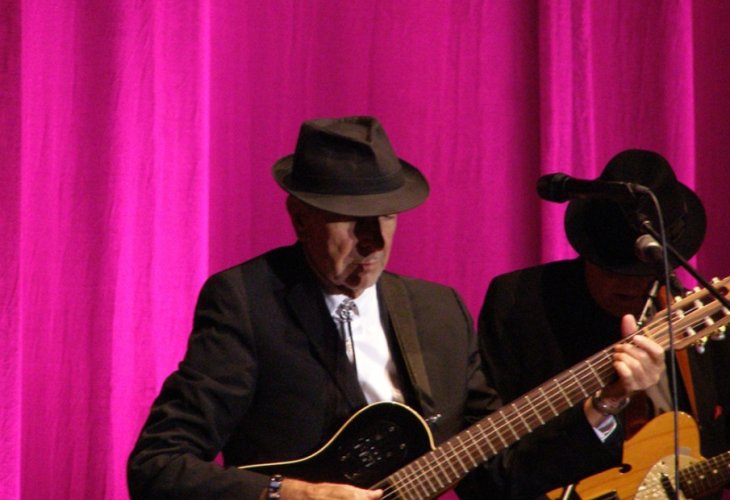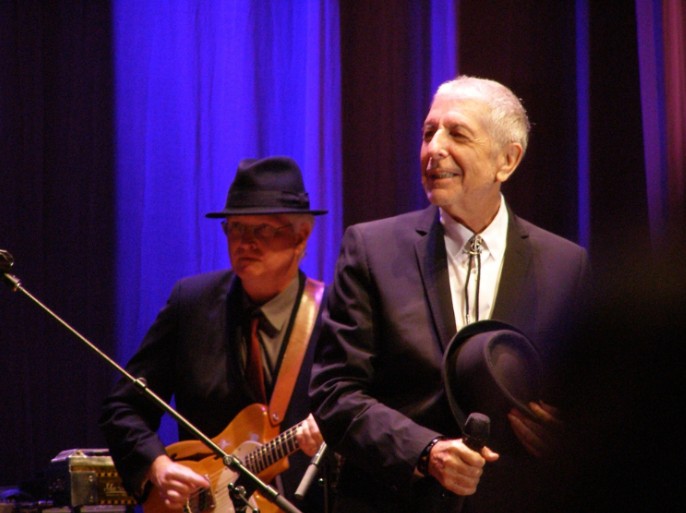Unveiling Leonard Cohen's Intimate Letters with the Montreal Cantor
Discover the heartfelt email exchanges between Leonard Cohen and Gideon Zelermyer, the cantor of 'Shaar Hashamayim' synagogue in Montreal.
 Leonard Cohen (Photo: shutterstock)
Leonard Cohen (Photo: shutterstock)In the letters Leonard Cohen wrote to Gideon Zelermyer, the cantor of 'Shaar Hashamayim' synagogue in Montreal, one can see his profound love for Judaism and the deep connection he felt to his people and faith. Cohen signed all these letters with his Jewish name: Eliezer. To each email, he attached a unique drawing of the Unified Heart—a symbol incorporating hands in the traditional priestly blessing gesture alongside a Star of David and a heart. This emblem was used by Cohen’s family in the past, and in his correspondence with the Jewish cantor, he felt compelled to conclude with this distinctly Jewish symbol.
Leonard Cohen was well-known for his deep appreciation of Jewish tradition. This is evident in his communications with the Jewish cantor, whom he viewed as the keeper of his family's heritage, and of course, in his songs. In his final album, released just two months before his death, Cohen included the 'Shaar Hashamayim' synagogue choir and even Zelermyer himself instead of ordinary background vocals. He requested in his will that Zelermyer oversee his funeral, thereby sealing the lifelong bond with his family’s synagogue in Montreal. The newly revealed correspondence sheds light on unique aspects of the musician’s personality.
Connection to Montreal
Leonard Cohen was born in Westmount, Montreal, in 1934, and he was 82 years old at his passing. His mother was the daughter of the head of the Kovno Yeshiva in Poland, and his father's grandfather was a leader of the Jewish community in Montreal. Cohen’s grandfather founded Canada's largest Orthodox synagogue—'Shaar Hashamayim'. Shortly before his death, Cohen told the 'New Yorker' magazine that he felt a tribal belonging to this synagogue and that he truly grew up there, appearing as a young boy in the synagogue's Hebrew school photo.
Zelermyer (41), has served as the cantor of 'Shaar Hashamayim' for 13 years. His connection with Cohen began about a decade ago. 'Shaar Hashamayim' often hosts musicians who pray in various styles, and one such individual, a relative of Cohen, gifted him a disk with cantorial pieces sung by Zelermyer. Cohen enjoyed the music, and the relative provided Zelermyer with Cohen’s email address, suggesting that Cohen would be delighted to hear from him. As Rosh Hashanah approached, Zelermyer sent Cohen a new year’s greeting, starting a warm correspondence between them.
Cohen’s response to the greeting was a pleasant email where he expressed delight at hearing from Zelermyer and happiness that he continued the synagogue's legacy. Before Passover that year, Zelermyer sent Cohen another holiday greeting and received a uniquely styled response: Cohen replied, “I will see you on Mount Sinai,” attaching the Unified Heart symbol and signing off with his Jewish name, Eliezer. Prior to Rosh Hashanah two years ago, Cohen sent Zelermyer a new year’s greeting, incorporating verses from the Priestly Blessing into the email. However, Cohen chose not to use Hashem’s name outright, instead replacing it with the Unified Heart symbol in these blessings.
The correspondences continued, mainly around holidays, with Cohen always responding to Zelermyer’s emails and often blessing him in Hebrew. Two years ago, ahead of Rosh Hashanah, Cohen sent Zelermyer a special greeting, writing, “I wish that your voice should ascend and reach Place, and bring blessings.” The capitalization of “Place” hinted at Cohen’s reference to Hashem.
"Finding the Synagogue's Sound"
About two months after Rosh Hashanah, Cohen reached out to Zelermyer with a surprising request. In his letter, he asked to "find the sound of 'Shaar Hashamayim'", and invited Zelermyer, along with the synagogue choir, to join the work on his new album. Zelermyer recounts that for this album, Cohen sought to create a more spiritual atmosphere, filled with depth. Within this ambiance, Cohen infused his songs with words from scriptures and prayers, such as “Here I Am” and “May His Great Name be Exalted.”
Zelermyer realized through the collaboration that this would be Cohen’s final album. During production, Cohen intended to travel to Montreal to record with the choir, but health issues prevented him from making the trip. Cohen’s son, Adam, who produced the album, explained to Zelermyer that despite his father’s complex medical situation rendering him unwell, the plan was still intact. Adam sent Zelermyer the lyrics showcasing Jewish sentiments, like quotes from the penitential prayers: “To You greatness belongs, to us shamefacedness.” The feeling was that Cohen wanted to close a circle with his last album.
The musical instructions Adam gave to Zelermyer clearly delineated Cohen’s desire: an echo of the synagogue in the album's songs. The preparations were kept secret until the final hour, even from choir members themselves, to prevent any leaks. Background vocals ranged from diverse styles, like cantorial singing, vividly recreating the synagogue prayer style.
One song involved background singing by the choir, incorporating quotes from the New Testament. The synagogue's rabbi permitted the choir to sing, and Zelermyer, together with Adam, crafted a unique blend for the piece: the choir rendered melodies from the Priestly Blessing at the beginning and end, aiming to portray a life story arc—Cohen, born Jewish, journeying through other faiths, yet finishing life again as a Jew.
 (Photo: shutterstock)
(Photo: shutterstock)Cohen greatly loved the result. A few days post-recording, he emailed Zelermyer, noting that his voice was clear and illuminated the song’s end. “I loved it. Eliezer,” Cohen concluded. A short while later, Cohen sent another email with the word “Here I am” in large letters, including a link to a video where the song “Hallelujah” is performed by the IDF Rabbinical Choir. Cohen remarked: “I hope you’ll enjoy the young soldiers' version.”
Not until late last year, just before the album’s release, did Zelermyer hear that the recordings he did with the choir would indeed accompany the album’s songs.
About a year ago, Cohen sent Zelermyer a self-portrait he had painted with charcoal and brush. Beneath the drawing, Cohen printed the words “To God full of delight they shall give sweet melodies”—a verse from the Shacharit prayers for Shabbat and festivals. Around the verse, Cohen stamped the Unified Heart symbol and added an ornate inscription alluding to the angels on Jacob’s ladder: “Just to be one of them, even in the lowest way.”
Here I Am
The song “Here I Am” from his final album symbolizes Cohen’s swan song. In it, he repeats the Hebrew word “Here I Am” several times, akin to the Binding of Isaac, with the synagogue choir accompanying. Cohen continues, singing, “I’m ready, my God.” The song consciously became his musical testament.
Before the album released, Cohen emailed Zelermyer again with a special request during the High Holy Days: to visit the graves of his ancestors. Zelermyer fulfilled Cohen’s wish, sending him photos of the family graves.
Zelermyer notes that Cohen was always connected to his Jewish roots, despite not being religious. He was a spiritual person, deeply interested in philosophy. Though he learned about different religions, he never sought a new faith, once telling 'The Guardian' he wasn’t looking for a new religion—he was happy with his Judaism.
Though Zelermyer and Cohen corresponded frequently and had a good relationship, they met in person only once—a few weeks before Cohen’s passing. Cohen held a press conference to launch his final album, which Zelermyer attended. Cohen entered the room after the full album was played. According to Zelermyer, Cohen appeared weak and pale but still dignified and humorous. After the press event, they met privately, where Zelermyer gave Cohen a significant gift: a Yom Kippur prayer book from the synagogue, awarded to Cohen’s late sister for scholastic achievement when she was about 12. The gift moved Cohen, who said it was very meaningful to him.
Less than two weeks before Cohen’s death, Zelermyer sent him a recording of one of his songs performed at the synagogue. Cohen replied, saying he enjoyed the recording. Zelermyer wished that Cohen’s great-grandfather, Lazarus, would have appreciated the song. Cohen quipped back, “He likes it. He’s dead, but we’re in touch,” a poignant acknowledgment that he sensed his own end approaching.
Cohen’s manager called Zelermyer to inform him of Cohen’s death, requesting spiritual guidance and sharing that Cohen had requested in his will for Zelermyer to officiate the funeral alongside the rabbi, in a traditional manner with few words. Cohen was buried in Montreal at the small family plot.
Zelermyer maintains contact with Cohen’s family, such as his daughter, whose son is named Leon, after Cohen’s grandfather who built 'Shaar Hashamayim'. Zelermyer also stays in touch with Adam, planning various musical projects to honor Cohen’s memory. Adam’s son attends a Jewish school, continuing the Jewish tradition Cohen held dearly.

